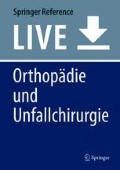Zusammenfassung
Der Morbus Sever-Haglund (Morbus Haglund, Morbus Sever, Apophysitis calcanei) zählt zu den juvenilen Osteochondr6osen. Es handelt sich um eine apophysäre Osteochondrose mit Beteiligung der Calcaneusapophyse, die die Insertionsregion der Achillessehne und der Plantarfaszie am Tuber calcanei darstellt. Das Krankheitsbild wurde erstmalig im Jahr 1907 durch den schwedischen Chirurgen und Orthopäden Patrick Haglund und im Jahr 1912 durch den amerikanischen Orthopäden Warren Sever beschrieben. Betroffen sind vornehmlich Jungen zwischen 5 und 12 Jahren. In diesem Altersbereich gilt der Morbus Sever-Haglund als häufigste Ursache des kindlichen Fersenschmerzes. Als Ursachen werden verschiedenste Risikofaktoren, verbunden mit einer (transienten) Perfusionsstörung und einer mechanischen Überlastung, diskutiert. Klinisch imponiert häufig eine geschwollene, druckdolente Apophysenregion. Die Erkrankung ist im klinischen Alltag oftmals eine klinische Diagnose, da die meisten konventionellen bildgebenden Kriterien als unspezifisch gelten. Der Morbus Sever-Haglund ist in der Regel selbstlimitierend und stellt eine Domäne der konservativen Therapie dar.
Literatur
Arnaiz J et al (2011) Imaging findings of lower limb apophysitis. AJR Am J Roentgenol 196(3):W316–W325
Arnold A et al (2017) Overuse physeal injuries in youth athletes. Sports Health 9(2):139–147
Atanda A Jr, Shah SA, O’Brien K (2011) Osteochondrosis: common causes of pain in growing bones. Am Fam Physician 83(3):285–291
Beck L, Heindel WL (2012) Apophysitis calcanei – apophysitis calcanei. Fortschr Röntgenstr 184(11):973–975
Brossmann J, Czerny C, Freyschmidt J (2000) Freyschmidts Köhler/Zimmer: Grenzen des Normalen und Anfänge des Pathologischen. Thieme, Stuttgart
Chiodo WA, Cook KD (2010) Pediatric heel pain. Clin Podiatr Med Surg 27(3):355–367
Elengard T, Karlsson J, Silbernagel KG (2010) Aspects of treatment for posterior heel pain in young athletes. Open Access J Sports Med 1:223–232
Fischer W, Bohndorf K (2007) Epiphysäre Osteonekrosen. Radiologie up2date 7(02):135–146
Gillespie H (2010) Osteochondroses and apophyseal injuries of the foot in the young athlete. Curr Sports Med Rep 9(5):265–268
Hefti F (1999) Fußschmerzen. Orthopade 28:173
Hosgoren B, Koktener A, Dilmen G (2005) Ultrasonography of the calcaneus in Sever’s disease. Indian Pediatr 42(8):801–803
Hotfiel T et al (2016) Einlagenversorgung im Leistungssport – Indikationen, Wirkungsweise, sportspezifische Versorgungsstrategien. Sports Orthop Traumatol 32(3):250–257
Hotfiel T et al (2017) Nonoperative treatment of tendon injuries. Sports Orthop Traumatol 33(3):258–269
Hussain S et al (2013) Sever’s disease: a common cause of paediatric heel pain. BMJ Case Rep 2013
James AM, Williams CM, Haines TP (2013) Effectiveness of interventions in reducing pain and maintaining physical activity in children and adolescents with calcaneal apophysitis (Sever’s disease): a systematic review. J Foot Ankle Res 6(1):16
Longo UG et al (2016) Apophyseal injuries in children’s and youth sports. Br Med Bull 120(1):139–159
Micheli LJ, Ireland ML (1987) Prevention and management of calcaneal apophysitis in children: an overuse syndrome. J Pediatr Orthop 7(1):34–38
Nehrer S, Huber W, Dirisamer A (2002) Apophysenschäden bei jugendlichen Sportlern. Radiologe 42:818
Peck DM (1995) Apophyseal injuries in the young athlete. Am Fam Physician 51(8):1891-5–1897-8
Freyschmidt J, Brossmann J, Wiens J et al (2003) Freyschmidt’s „Koehler/Zimmer“ borderlands of normal and early pathological findings in skeletal radiography. ISBN 9781588901507
Scharfbillig RW, Jones S, Scutter SD (2008) Sever’s disease: what does the literature really tell us? J Am Podiatr Med Assoc 98(3):212–223
Wiegerinck JI et al (2014) Incidence of calcaneal apophysitis in the general population. Eur J Pediatr 173(5):677–679
Wirth T (2018) Juvenile Osteochondrosen und Osteonekrosen. Orthop Unfall 13(01):67–78
Author information
Authors and Affiliations
Corresponding author
Editor information
Editors and Affiliations
Section Editor information
Rights and permissions
Copyright information
© 2019 Springer-Verlag GmbH Deutschland, ein Teil von Springer Nature
About this entry
Cite this entry
Hotfiel, T., Forst, R. (2019). Morbus Sever-Haglund. In: Engelhardt, M., Raschke, M. (eds) Orthopädie und Unfallchirurgie. Springer Reference Medizin. Springer, Berlin, Heidelberg. https://doi.org/10.1007/978-3-642-54673-0_6-1
Download citation
DOI: https://doi.org/10.1007/978-3-642-54673-0_6-1
Received:
Accepted:
Published:
Publisher Name: Springer, Berlin, Heidelberg
Print ISBN: 978-3-642-54673-0
Online ISBN: 978-3-642-54673-0
eBook Packages: Springer Referenz Medizin

